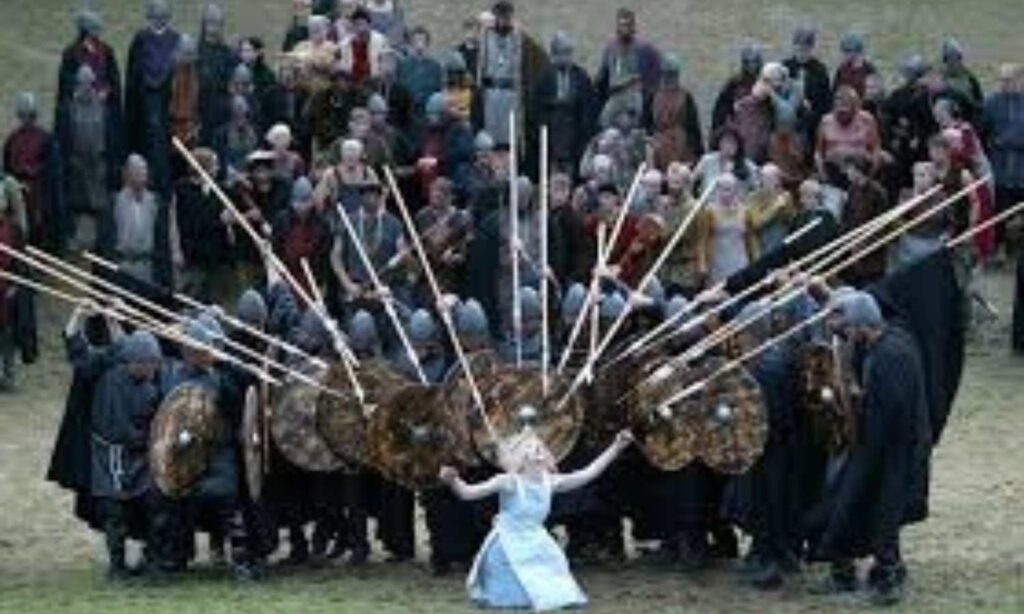A farmer stands on a windswept hill, his eyes fixed on the horizon, torn between loyalty to a king and the whispers of rebellion. This isn’t just a story—it’s the heartbeat of Norway’s Saint Olav Drama, a performance that unfolds every July on the very soil where history was forged. In the small town of Stiklestad, where King Olav Haraldsson fell in 1030, thousands gather to witness a spectacle that’s equal parts theater, pilgrimage, and cultural awakening. Locals call it a journey through time, but is it Norway’s most emotionally moving festival? Let’s dive into the drama, the history, and the voices of those who live it.
A Stage Set by History
The Saint Olav Drama, or Spelet om Heilag Olav, isn’t just a play—it’s a living bridge to Norway’s past. Performed annually since 1954 at Scandinavia’s largest open-air theater in Stiklestad, it recreates the final days of Olav Haraldsson, the Viking king who became Norway’s patron saint. His death at the Battle of Stiklestad in 1030 marked a turning point, cementing Christianity’s roots in a nation once ruled by Norse gods. The drama, written by Olav Gullvåg with music by Paul Okkenhaug, captures this clash of faith, power, and human struggle.
- Why it matters: The play is staged on the actual battlefield, blending historical authenticity with raw emotion.
- Who’s involved: Over 700 people, from professional actors to local volunteers, bring the story to life.
- When it happens: Held during the Olsok festival, July 24–29, 2025, with performances on July 25, 26, 27, and 29.
Locals say standing on that hallowed ground, watching Olav’s story unfold, feels like touching history itself.
The Emotional Pulse of the Drama
The Saint Olav Drama isn’t your typical theater experience. It’s performed outdoors, under the vast Norwegian sky, where the wind carries echoes of the past. The story follows the events at Sul Farm, where farmers grapple with Olav’s return from exile and the looming battle. Characters like Gudrid, who sees the king as an intruder, and Torgeir, who pledges loyalty, embody the human cost of a nation in transition. The audience feels their fear, hope, and defiance.
- A local’s take: “It’s like the land itself is speaking,” says Marit, a Verdal resident who’s attended for 20 years. “You feel the weight of their choices.”
- The music: Paul Okkenhaug’s score weaves haunting melodies that amplify the emotional stakes.
- The setting: The open-air stage, framed by Stiklestad’s rolling hills, makes every scene visceral.
For many, the drama’s power lies in its ability to humanize history, turning distant figures into people you ache for.
A Festival That Binds Community
The Olsok festival, or “Olav’s Wake,” surrounds the drama with a vibrant celebration of Norwegian culture. Held in late July, it draws thousands to Stiklestad and nearby Trondheim. Beyond the play, the festival offers medieval markets, concerts, and workshops, creating a tapestry of tradition and community. Locals don’t just attend—they participate, whether as actors, craftsmen, or storytellers, making it a shared ritual.
- Medieval market: Artisans sell handcrafted goods, from woolen textiles to carved wooden figures.
- Community spirit: Volunteers, including children, join in reenactments and activities, fostering a sense of belonging.
- Pilgrimage connection: Many walk the St. Olav’s Path, a historic route to Nidaros Cathedral, tying the festival to spiritual roots.
“It’s our history, but it’s also who we are now,” says Lars, a local farmer who plays a Viking each year. “We’re telling our own story.”
What Locals Say: Voices from the Heart
To understand the festival’s emotional impact, I spoke with locals in Verdal and Trondheim. Their stories reveal why the Saint Olav Drama resonates so deeply. For Anna, a 35-year-old teacher, it’s about identity: “Watching Olav’s struggle, I feel proud to be Norwegian. It’s like he’s still teaching us to stand for something.” Others, like Erik, a retiree, find personal meaning: “I lost my wife last year, and the play’s themes of faith and sacrifice hit me hard. I cried through the final scene.”
- Emotional connection: Many describe feeling a mix of awe, sorrow, and pride.
- Generational bond: Families attend together, passing down the tradition to children.
- Visitor feedback: Tourists often note the locals’ warmth, with one TripAdvisor review calling it “a festival that feels like a hug from Norway.”
These voices paint a picture of a festival that’s more than entertainment—it’s a mirror for the soul.
A Historical Turning Point
To grasp the drama’s weight, you need to know Olav’s story. Born around 995, Olav Haraldsson was a Viking king who ruled Norway from 1015 to 1028. His mission to Christianize the country sparked resistance from nobles and farmers who clung to pagan traditions. Exiled by rivals and the Danish king Cnut the Great, Olav returned in 1030, only to die at Stiklestad. Miracles reported at his grave led to his canonization in 1031, making him Saint Olav, Norway’s eternal king.
- Why it’s pivotal: Olav’s death unified Norway as a Christian kingdom, shaping its national identity.
- Lasting legacy: His axe became part of Norway’s coat of arms, and over 300 churches across Europe bear his name.
- Cultural echo: The drama reflects this shift, showing the tension between old and new beliefs.
Locals see Olav not just as a saint but as a symbol of resilience, a thread woven into Norway’s cultural fabric.
The Festival’s Modern Relevance
The Saint Olav Drama doesn’t just dwell on the past—it speaks to today. Each year, directors tweak the play to highlight contemporary themes, like faith versus doubt or the cost of leadership. In 2025, the festival’s theme of “escape” at Trondheim’s Olavsfest explores how people flee from or toward something greater, mirroring Olav’s own journey. This keeps the story fresh, resonating with younger audiences and global visitors.
- Inclusivity: The festival embraces diverse voices, with events like Sami cultural showcases.
- Sustainability: Organizers use eco-friendly practices, like digital ticketing, to stay relevant.
- Global draw: Over 800,000 have seen the drama since 1954, with international pilgrims joining locals.
“It’s not just about 1030,” says festival director Ingrid, “it’s about what we’re wrestling with now—belief, community, courage.”
Immersing in the Medieval Market
Step into the medieval market, and you’re transported to 11th-century Norway. Stalls brim with local delicacies like rakfisk (fermented trout) and hand-forged ironwork. Craftsmen demonstrate ancient techniques, from weaving to blacksmithing, while jugglers and musicians add to the festive hum. It’s a sensory feast, with the scent of fresh bread and the clink of coins creating a time-warp effect.
- What to try: Sample flatbrød (crispbread) or sodd, a traditional Trøndelag soup.
- Interactive fun: Kids can try archery or dress as Vikings, blending education with play.
- Local pride: Artisans like Solveig, a weaver, say, “This is my heritage—I’m sharing my ancestors’ skills.”
The market doesn’t just entertain—it connects you to Norway’s living traditions.
The Spiritual and Cultural Crossroads
For many, the festival is a pilgrimage. Stiklestad and Nidaros Cathedral, where Olav’s body was taken after his death, are sacred sites. Pilgrims walk the St. Olav’s Path, a 640-km trail from Oslo to Trondheim, seeking spiritual renewal. The drama amplifies this, blending faith and history into a shared experience. Even non-religious attendees feel the weight of the moment when Olav falls on stage.
- Pilgrimage impact: Thousands walk the path annually, with some joining just for the festival.
- Cultural blend: The event unites Catholic, Lutheran, and secular Norwegians in celebration.
- Emotional peak: The play’s climax, Olav’s death, often leaves audiences in silent reflection.
“It’s like a church service and a history lesson in one,” says pilgrim Hanna, who walked the path in 2024.
Challenges and Criticisms
No festival is perfect. Some locals argue the drama can feel repetitive, with its annual retelling of the same story. Others note the festival’s growing commercialization, with ticket prices (starting at 280 NOK) and crowded markets deterring some residents. Accessibility is another concern—rural Stiklestad isn’t easy to reach without a car, and public transport options are limited.
- Local gripes: “It’s become a tourist trap,” says Bjørn, a Verdal shopkeeper, though he admits it boosts the economy.
- Balancing act: Organizers strive to keep the play authentic while appealing to modern audiences.
- Solutions in progress: More shuttle buses and online streaming options are being explored for 2025.
Despite these hurdles, the festival’s emotional core keeps locals coming back.
Tips for Experiencing the Festival
Planning to attend? Here’s how to make the most of the Saint Olav Drama and Olsok festival:
- Book early: Tickets for the drama sell out fast. Check stiklestad.no for 2025 dates.
- Dress smart: July weather in Stiklestad can be chilly. Bring layers and comfy shoes for walking.
- Explore beyond the play: Visit the Stiklestad Cultural Centre’s folk museum or join a guided tour.
- Engage with locals: Chat with artisans or volunteers—they’re eager to share stories.
- Taste the culture: Don’t miss local dishes like kjøttkaker (meatballs) at the medieval market.
A little preparation turns a visit into an unforgettable journey.
Why It Stays With You
The Saint Olav Drama isn’t just a performance—it’s a shared heartbeat, a moment where Norway’s past and present collide. Locals like Marit and Lars describe it as a ritual that grounds them, a reminder of their roots and resilience. For visitors, it’s a chance to step into a story that’s shaped a nation. Whether you’re drawn by history, faith, or the sheer power of storytelling, the festival leaves a mark. So, is it Norway’s most emotionally moving cultural event? Ask the locals, and they’ll tell you: it’s not just a festival—it’s a feeling.
What’s your take—could a single play capture the soul of a nation? Plan a trip to Stiklestad in 2025 and find out for yourself.










